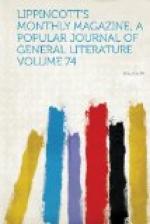[Illustration: TOMB OF BURKE.]
Not on land only, but on the river, whereinto it so gradually blends, does lush young England dissipate. Cricket and football order into violent action both pairs of extremities, while the upper pair and the organs of the thorax labor profitably at the oar. The Thames, in its three bends from Senly Hall, the Benny Havens of Eton, down to Datchet Mead, where Falstaff overflowed the buck-basket, belongs to the boys. In this space it is split into an archipelago of aits. In and out of the gleaming paths and avenues of silvery water that wind between them glide the little boats. The young Britons take to the element like young ducks. Many a “tall admiral” has commenced his “march over the mountain wave” among these water-lilies and hedges of osier.
Shall we leave the boys at play, and, renewing our youth, go ourselves to school? Entering the great gate of the western of the two quadrangles, we are welcomed by a bronze statue of the founder of the institution, Henry VI. He endowed it in 1440. The first organization comprised “a provost, four clerks, ten priests, six choristers, twenty-five poor grammar-scholars, and twenty-five poor infirm men to pray for the king.” The prayers of these invalids were sorely needed by the unhappy scion of Lancaster, but did him little good in a temporal sense. The provost is always rector of the parish. Laymen are non-eligible. Thus it happens that the list does not include two names which would have illuminated it more than those of any of the incumbents—Boyle the philosopher, “father of chemistry and brother of the earl of Cork,” and Waller the poet. The modern establishment consists of a provost, vice-provost, six fellows, a master, under-master, assistants, seventy foundation scholars, seven lay clerks and ten choristers, with a cortege of “inferior officers and servants”—a tolerably full staff. The pay-students, as they would be termed in this country, numbering usually five to six hundred, do not live in the college precincts, but at boarding-houses in the town, whence their designation of oppidans, the seventy gowns-men only having dormitories in the college. The roll of the alumni contains such names as the first earl of Chatham, Harley, earl of Oxford, Bolingbroke, Fox, Gray, Canning, Wellington and Hallam. That is enough to say for Eton. The beauties of the chapel, the treasures of the library and the other shows of the place become trivial by the side of the record.
[Illustration: HEDSOR AND COOKHAM CHURCHES.]
Over the “fifteen-arch” bridge, which has but three or four arches, we pass to the town of Windsor, which crouches, on the river-side, close up to the embattled walls of the castle—so closely that the very irregular pile of buildings included in the latter cannot at first glance be well distinguished from the town. High over all swells the round tower to a height above the water of two hundred and twenty feet—no excessive altitude,




